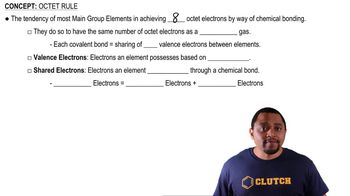Which of the following statements about benzene, C6H6, is or are true?
i. Benzene has two equivalent resonance structures.
ii. There are no nonbonding pairs in the Lewis structure for benzene.
iii. Benzene has three short and three long C—C bonds.
 Verified step by step guidance
Verified step by step guidance


Which of the following statements about benzene, C6H6, is or are true?
i. Benzene has two equivalent resonance structures.
ii. There are no nonbonding pairs in the Lewis structure for benzene.
iii. Benzene has three short and three long C—C bonds.
b. Which of these compounds or ions is an exception to the octet rule: nitrogen dioxide, borohydride (BH4−), borazine (B3N3H6 which is analogous to benzene with alternating B and N in the ring), or boron trichloride?
Draw the Lewis structures for each of the following molecules or ions. Identify instances where the octet rule is not obeyed; state which atom in each compound does not follow the octet rule; and state how many electrons surround these atoms: a. NO, b. BF3, c. ICl2−, d. OPBr3 (the P is the central atom), e. XeF4.
In the vapor phase, BeCl2 exists as a discrete molecule. (a) Draw the Lewis structure of this molecule, using only single bonds. Does this Lewis structure satisfy the octet rule?
In the vapor phase, BeCl2 exists as a discrete molecule. (c) On the basis of the formal charges, which Lewis structure is expected to be dominant for BeCl2?